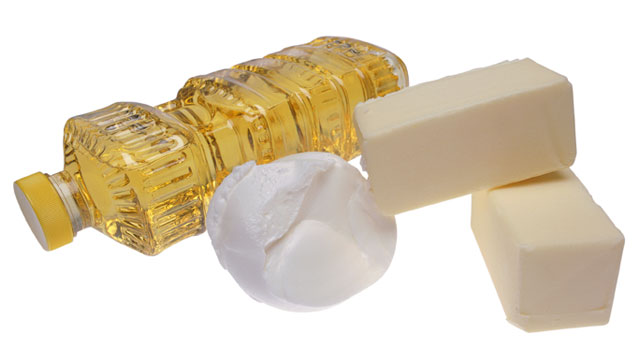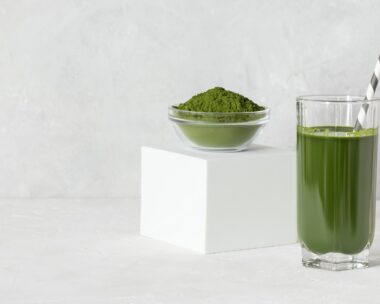Not all fat is bad. Fats are an essential part of healthy eating so it’s good for you to eat a certain amount of the healthier fats. Here we clarify the differences between healthy and unhealthy fats and the foods you need to try to include in your diet and those you should avoid.
A healthy balanced diet should include the healthier monounsaturated and polyunsaturated fats. However, it’s not always easy to know where to find them or how to use them in meals. Below is a guide to using healthier fats in your meals and snacks.
1. Monounsaturated fat is found in foods such as avocados, almonds, cashews, peanuts and cooking oils made from plants or seeds such as sunflower, canola, soybean, olive, sesame and peanut oils.
Avocado and nuts can be added to salads and a handful of unsalted nuts make a healthy snack any time of the day. Try a handful of almonds sprinkled over breakfast cereal.
2. Polyunsaturated fat (omega-6) is found in foods such as fish, tahini (sesame seed spread), margarine, linseed (flaxseed), sunflower and safflower oil, pine nuts and brazil nuts.
Tahini can be used as a spread on crackers instead off butter or used as a base for dips, sauces and stews
Choose margarine made from sunflower and safflower oils, and use instead of butter on sandwiches and toast
Sprinkle ground linseed on breakfast cereal or choose wholegrain bread with linseeds. Add pine nuts or sesame seeds to salads or sprinkle over vegetables.
Polyunsaturated fat (omega-3s) is found in oily fish such as tuna, salmon, sardines and blue mackerel as well as walnuts and linseeds.
We recommend eating two or three serves (150 grams per serve) of oily fish every week. Walnuts and ground linseeds can be added to stir fries or sprinkled on breakfast cereal.
1. Saturated fats are found in foods such as fat on meat, chicken skin, full fat dairy products, butter and take-away foods. Saturated fats are always listed on the nutrition panel so when choosing between foods in the supermarket, compare the nutrition information panel on the back and choose the one lowest in saturated fat.
Hard and full fat soft cheeses
Full fat dairy products
Cream
Crème fraiche
Chicken skin
Fat on meats
Processed meat such as sausages, burgers and salami
Pastry
Coconut oil
Coconut milk
Palm oil
Fatty or fried take-away foods
Packaged cakes and biscuits
2. Swap butter for a margarine spread made from canola, sunflower, olive or dairy blends. Just doing this with your daily toast will remove 2.85 kg of saturated fat from your diet in one year.
3. Cut the fat. Trim all visible fat from meat, remove skin from chicken and try to avoid processed meat (e.g. sausages and salami) unless it has the Heart Foundation Tick.
4. Eat two to three serves of oily fish a week. A serve of fish is 150 g, which is about the size of your whole hand. Add fish oil capsules and omega-3 enriched foods and drinks to your diet if you’re not eating enough oily fish.
5. Choose healthier treats. Cakes, pastries and biscuits are one of the main sources of saturated fat in our diets. Raisin bread, Tick approved cereal and nut bars, or Tick approved sweet biscuits are healthier options. Limit pastries, pizza, fried fish, hamburgers, hot chips and creamy pasta to once a week.
Naturally occurring trans fats are found in small amounts in dairy products, beef, veal, lamb and mutton. Artificial, synthetic, industrial or manufactured trans fats are caused by the way some fats and oils are processed. They are found in foods that use hydrogenated or partially hydrogenated vegetable fats, such as deep-fried and baked foods.
Choose polyunsaturated and monounsaturated spreads and margarines
Choose lean meat trimmed of all visible fat
Choose reduced, low or no fat dairy foods
Try to limit the amount of fast foods and take-away meals including deep-fried and baked foods including store bought biscuits, pastries, pies and cakes that you eat.
Avoid foods that show ”hydrogenated oils” or “partially hydrogenated vegetable oils” in the ingredients list. However, the law doesn’t currently enforce companies to list these fats on labels. The Heart Foundation is lobbying government for mandatory labelling of trans fat but in the meantime, look for foods with the Heart Foundation Tick.
To earn the Heart Foundation Tick, vegetable oils and margarines must contain no more than 1% trans fat as part of their total fat. Other products must be virtually free (trace levels only) of trans fat to qualify for the Tick. “Virtually free” allows for trans fats that occur naturally in foods.
Together we can change the shape of Australia.
Related video: Which margarine is best?
Nutritionists give their opinion on the spreads promising longevity, lower cholesterol and better health.




